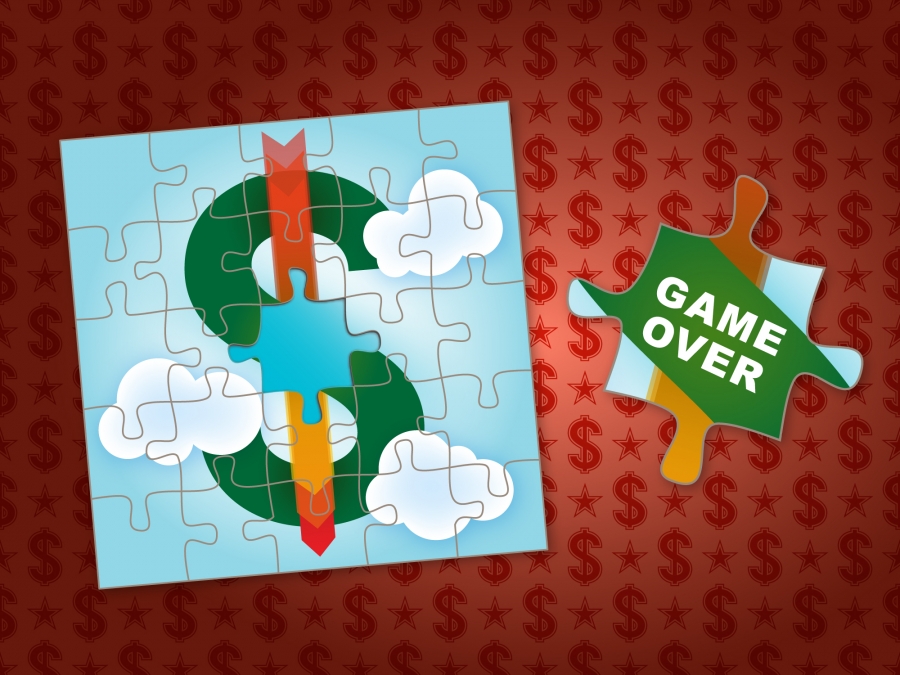What Does Falling Money Velocity Tell Us?
A falling dollar? Image Credit: Flickr.com/Horia Varlan
In our last post, Should We Expect Inflation or Deflation?, we discovered several things about why we have essentially zero inflation. First, one really big reason QE was not inflationary (and, I am sure, not nearly as stimulative as the Fed would have liked) was that about 80% of it never entered the economy, but stays parked even today in Federal Reserve excess reserves. Of course there is no guarantee that QE money will stay parked in excess reserves. Just as the member commercial banks of the Federal Reserve voluntarily deposited that QE money in excess reserves, they can voluntarily remove it as well. If the Fed ceases paying sufficient interest on the excess reserves to motivate the banks to keep their money there, or if the banks find large, lucrative loans to companies that would return greater rewards with sufficiently low risk, banks can turn on a dime and take some or all QE money out of excess reserves. If all of that $3.6 trillion (80% of the $4.5 trillion in assets bought by the Fed under QE) really did enter the economy, just its size (about 21% of current GDP of $17.3 trillion) would seem to ensure a very high rate of inflation. Let us fervently hope that will not happen.
Yet another piece-of-the-puzzle we learned was that the only reason we were not suffering high inflation was because of the falling velocity of M2 money. As we found in the previous post, the fractional change in the price index that is the inflation rate is given by
where P is the price index, M is the amount of M2 money in the economy, V is the velocity of M2 money, and y is the real GDP. We also found from Federal Reserve Economic Database (FRED) data that the latest values of these fractional changes are
ΔM/M = 5.73%, ΔV/V = -2.16%, Δy/y = 2.88%, so that
ΔP/P = 5.73 – 2.16 – 2.88 = 0.71 %
Given measurement errors, I would would not be surprised if this result was statistically insignificantly different from an inflation rate of zero.If the fractional change in money velocity over a year were even just zero, i.e. money velocity unchanged, we would have had an inflation rate of 2.9%. It seems obvious then that the only reason for essentially no inflation is a large decline in the money velocity. Consider again the M2 money velocity shown as the blue curve and the percent change in the M2 money velocity shown as the red curve in the plot below.

What does this tell us? Why should the money velocity be falling? If your premonition is telling you it can not mean anything good, I think your premonition is being very accurate. With at best modest economic growth, falling monetary velocity can only mean that households, companies, and governments are together spending money more slowly. Keynesians, seeing this evidence, will tell us as they always do that this plot is one more sign we need governments to do even more stimulative spending.
As I have emphasized many times, such Keynesian “stimulation” schemes are far more likely to result in misallocated economic resources that are ultimately wasted. See Why Socialism Does Not Work. While that post argued against pure socialism, an economic system where the means of production are owned and managed by the state, those arguments are equally applicable to most state economic intervention in a mixed economy, where both state and non-state (particularly corporate) agents contend for control of the economy. This is most particularly true for state allocation of economic resources as opposed to allocation of resources by the free-market price system. Even Oskar Lange with his program of market socialism in the Soviet Union could not do better than the free-market’s “Invisible Hand”, as the Soviet Union learned to its cost when it was “dumped on the ash-heap of History”.
A more fruitful procedure would try to understand why everyone is spending so much more slowly. For example one disincentive for banks, particularly small banks, to offer loans to businesses comes in the form of Dodd-Frank Act regulation of banks. In addition the Obama administration has created an almost exponential growth of regulations, as seen in the www.heritage.org post Red Tape Rising: Six Years of Escalating Regulation Under Obama. How can a government make private economic activity immensely more difficult and expect to get more of it? Also see Even Some Progressives Becoming Worried About the Economy and The Burden of Government Regulations and The EPA, CO2, Mercury Emissions, and Green Energy for more discussion on this subject. Even more discouragement of private sector activity is heaped-on from the tax system as we noted in the post Economic Effects of Current Tax Policy. In addition, Obamacare is hurting the middle class with exorbitant medical insurance cost increases, leaving it with less disposable income to purchase other products of the economy.
Could it be that the primary reason for slowing money velocity and therefore slowing economic activity is the difficulties companies have in making a profit in this country? Why else would companies borrow money to buy back their own stock rather than invest in new productive capacity? Why else would American small business startups be virtually non-existent? Why else would so many millions of discouraged workers leave the work force? Why else would the American middle class be disappearing?
Views: 3,099





























